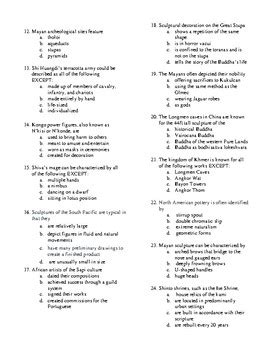The AP Art History exam is a challenging but rewarding assessment that tests students’ knowledge of the history of Western art. If you’re preparing for this important exam, it’s crucial to practice as much as possible. This article provides a comprehensive collection of practice questions, designed to cover all aspects of the AP Art History curriculum.

-
Which of the following is a characteristic of Romanesque architecture?
- Pointed arches
- Flying buttresses
- Thick walls
- Stained glass windows
-
Who is credited with developing the sfumato technique?
- Michelangelo
- Leonardo da Vinci
- Raphael
- Caravaggio
-
Which of the following movements in art history is known for its emphasis on geometric abstraction?
- Cubism
- Fauvism
- Impressionism
- Surrealism
-
What material was primarily used for sculptures during the Greek Classical period?
- Bronze
- Marble
- Wood
- Terracotta
-
Which of the following is considered the “Birthplace of Modern Art”?
- Vienna
- Paris
- New York
- London
Section I: Art and Culture
- Discuss the influence of ancient Egyptian art on Greek sculpture.
- Explain how the Renaissance humanism influenced the development of painting.
- Analyze the social and political factors that contributed to the rise of Romanticism in the 19th century.
Section II: Art and the Artist
- Explain the techniques and materials used by Rembrandt in his self-portraits.
- Analyze the symbolism and allegory in the work of Pablo Picasso.
- Discuss the role of the patron in the production and patronage of art.
- Name three iconic works of art from the High Renaissance.
- Describe the characteristics of Baroque architecture.
- What is “trompe l’oeil”?
- Who is known as the “Father of Modern Architecture”?
- Define the term “primitivism” in art history.
Table 1: Art Periods and Movements
| Period/Movement | Dates | Key Artists | Notable Works |
|---|---|---|---|
| Gothic | 12th-16th centuries | Giotto, Duccio | Notre Dame Cathedral, Amiens Cathedral |
| Renaissance | 14th-17th centuries | Leonardo da Vinci, Michelangelo | Mona Lisa, Sistine Chapel ceiling |
| Baroque | 17th-18th centuries | Bernini, Caravaggio | St. Peter’s Basilica, The Calling of St. Matthew |
| Impressionism | 19th century | Monet, Renoir | Water Lilies, Dance at Le Moulin de la Galette |
| Modernism | Early 20th century | Picasso, Matisse | Guernica, Red Room |
Table 2: Art Techniques and Materials
| Technique/Material | Artist/Period | Notable Examples |
|---|---|---|
| Fresco | Renaissance | Sistine Chapel ceiling |
| Oil painting | Baroque | The Calling of St. Matthew |
| Lithography | 19th century | Whistler’s Nocturnes |
| Collage | Modernism | Picasso’s Guitar |
| Photography | 20th century | Cartier-Bresson’s Decisive Moment |
Table 3: Arts of the World
| Region | Notable Arts | Key Artists |
|---|---|---|
| Asia | Chinese painting, Japanese calligraphy | Li Bai, Zhang Daqian |
| Africa | Masks, sculptures | Chokwe people, Yoruba people |
| North America | Native American pottery, Navajo weaving | Maria Martinez, R.C. Gorman |
| South America | Incan goldwork, Mayan ceramics | Inca Empire, Mayan civilization |
| Oceania | Aboriginal bark paintings, Maori wood carvings | Emily Kngwarreye, Tame Iti |
Table 4: Major Art Museums
| Museum | Location | Notable Collections |
|---|---|---|
| Louvre Museum | Paris, France | Greek sculpture, Italian Renaissance paintings |
| Metropolitan Museum of Art | New York City, USA | Egyptian antiquities, American art |
| Uffizi Gallery | Florence, Italy | Italian Renaissance paintings, Medici collections |
| Hermitage Museum | St. Petersburg, Russia | Rembrandt’s Return of the Prodigal Son, Leonardo da Vinci’s Madonna Litta |
| Tate Modern | London, England | Modern and contemporary art, Picasso’s Guernica |
- Start preparing early and make studying a regular habit.
- Familiarize yourself with the AP Art History curriculum and format.
- Practice answering a variety of question types, including multiple choice, free response, and short answer.
- Study the works of art firsthand whenever possible.
- Use visual resources, such as reproductions and online databases, to enhance your understanding.
- Form study groups with classmates and discuss art concepts and ideas.
- Seek feedback from your teacher or a tutor to identify areas for improvement.
Pros:
- Reinforces understanding of art history concepts.
- Improves test-taking skills.
- Provides feedback on areas of strength and weakness.
- Reduces anxiety and increases confidence on exam day.
Cons:
- Can be time-consuming.
- May not cover all the topics that will appear on the exam.
- Over-reliance on practice questions can lead to a narrow focus.
-
How many questions are on the AP Art History exam?
- 150 multiple choice questions and 5 free response questions.
-
How is the AP Art History exam scored?
- Multiple choice questions: 50%
- Free response questions: 50%
-
What is the passing score for the AP Art History exam?
- A score of 3 or higher is considered passing.
-
What is the best way to prepare for the AP Art History exam?
- Practice, practice, practice!
-
Can I use notes on the AP Art History exam?
- No, notes are not allowed.
-
What should I bring to the AP Art History exam?
- Pencils, erasers, and a calculator.
-
How long do I have to take the AP Art History exam?
- 3 hours and 15 minutes.
-
When is the AP Art History exam administered?
- The exam is typically administered in May of each year.
